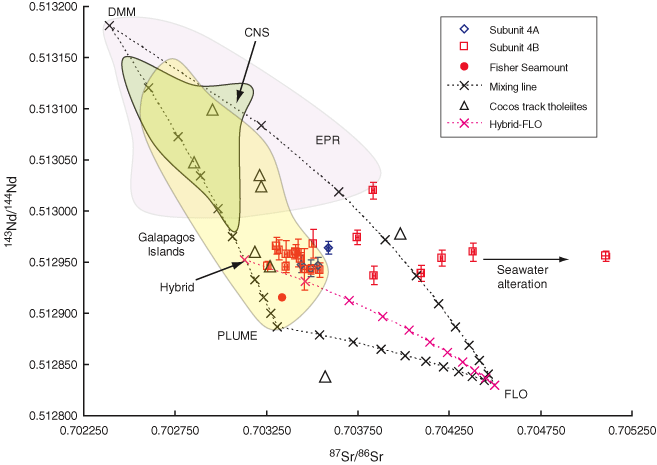
Figure F10. 143Nd/144Nd vs. 87Sr/86Sr, illustrating mixing relationships between regional geochemical end-members. Binary mixing lines are in increments of 10%. Seawater alteration is expected to elevate 87Sr/86Sr, as indicated. The narrow range in Nd isotope values suggests that Subunits 4A and 4B derive from approximately the same source that is a mixture of ~50%–70% enriched (PLUME) and 30%–50% depleted (DMM) sources. The hybrid composition represents mixture of 60% PLUME + 40% DMM end-members. Leg 205 samples do not appear to have a significant admixture of the FLO end-member. East Pacific Rise (EPR; 5°–15°N) and Cocos-Nazca spreading center (CNS) fields are drawn from published data available from the Petrological Database of the Ocean Floor (www.petdb.org); Galápagos Island data are from the Geochemistry of Rocks from the Oceans and Continents (GEOROC) database (georoc.mpch-mainz.gwdg.de/georoc). Cocos Track tholeiites are selected from analyses by Werner et al. (2003) and Harpp et al. (2005). PLUME, DMM, and FLO represent regional geochemical end-members after (Harpp and White, 2001). Leg 205 data are from V. Chavagnac, unpubl. data. Model input parameters as follows: PLUME: 87Sr/86Sr = 0.70331, 143Nd/144Nd = 0.512887, Sr = 21.1 ppm, and Nd = 1.354 ppm; FLO: 0.7045, 0.51283, 45, and 2; DMM: 0.702389, 0.513181, 7.664, and 0.581; hybrid: 70313, 0.51295, 15.726, and 1.045. PLUME concentration data from Sun and McDonough, 1989. PLUME and DMM isotope values from analyses of published values for EPR and the Galápagos Islands. FLO isotope data from Harpp and White, 2001. FLO concentration data are estimated from reasonable back-calculation of lavas from Isla Floreana (White et al., 1993). DMM concentration data are from Workman and Hart (2005).


![]()